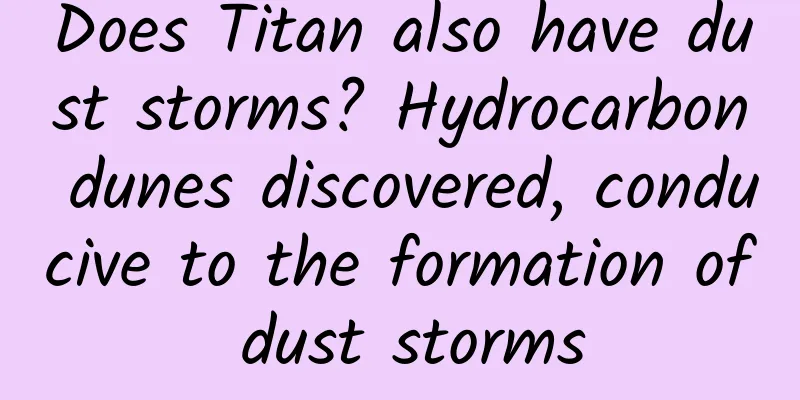Does Titan also have dust storms? Hydrocarbon dunes discovered, conducive to the formation of dust storms

|
[Mobile software: Bo Ke Yuan] In a new study published in the journal Geophysical Research Letters, meteorological conditions on Saturn's large moon Titan appear to be favorable for the formation of dust storms. Titan is the most Earth-like, strange and distant satellite world in the solar system. If true, these dry cyclones may be the main promoter of dust on Titan's surface, just like on Mars. The Cassini spacecraft toured the Saturn system between 2004 and 2017, observing dunes in the moon's equatorial region, covering up to 30% of the surface, and observed a large dust storm. "The dust on Titan's dunes is thought to come from hydrocarbon aerosols in Titan's atmosphere," said Brian Jackson, a planetary scientist at Boise State University in Idaho and lead author of the new study. "It likely has a plastic texture, unlike the more familiar grit found on Earth or Mars. Rare large dust storms look impressive, but dust storms send more total dust into the atmosphere, even on Earth, where winds are more influential than on Mars or Titan." "Winds on Titan's surface are usually very weak and probably not that strong unless a large storm passes through, so dust storms could be one of the main dust transport mechanisms on Titan. Dust storms have not been observed on Titan, but the authors of the new study predicted their possible presence by applying a meteorological model to data obtained from the surface during a brief visit by the Cassini Huygens probe in 2005. Dust storms form in dry, calm conditions when sunlight warms the ground and near-surface air." Mysterious dust Rising warm air creates visible vortices in which sand and dust are picked up. Dust storms share some of the same physical properties as tornadoes, but they are always dry and don't get as large and destructive as tornadoes, but scientists don't fully understand how dust storms work. When you plug in numbers for how much dust a dust storm should pick up based on the wind speeds you see, they seem to be able to pick up more dust than expected. There may be some other mechanism that helps pull up the dust, or the formula is wrong. Researchers are making an in-depth observation effort by chasing dust storms in southeastern Oregon's Alvord Desert using small drones carrying weather instruments. During the Martian summer, unusually dry conditions on the Red Planet produce many dust storms, when they can grow large, up to 8 kilometers (5 miles) high. Because the Martian atmosphere is so thin, even 200-mile-per-hour winds cause only minor vibrations. This makes the dust-raising abilities of dust storms very important to the global movement of dust on Mars. "We can watch dust devils sweep across the surface of Mars and see what their internal structure looks like, but that doesn't tell us how much dust they kick up. The Martian atmosphere is really, really dusty, and dust plays a big role in the climate. Dust devils are probably one of the most important mechanisms for kicking up dust, if not the main mechanism. Dust devils on Titan, if they exist, might be just as important, even though Titan's surface winds are generally mild for the exact opposite reason: Titan's atmosphere is 1.5 times denser than Earth's, but Titan's gravity is only one-seventh that of Earth's, which makes Titan's atmosphere hard to move around." It's just this big, fluffy atmosphere. When there's so much air, it's hard to keep it agitated, so Titan's surface doesn't usually get very windy. Like Earth's atmosphere, Titan's atmosphere is mostly nitrogen, but it also contains appreciable amounts of ethane and methane, the main components of natural gas. Titan is the only body in the solar system besides Earth where scientists have observed evidence of flowing rivers and liquid surface lakes, but scientists think these Earth-like features on cold and distant Titan are not water, but liquid hydrocarbons. The new study's dust storm predictions may have to wait until NASA's Dragonfly mission arrives in 2034 to be confirmed. Getting buffeted by a dust storm while exploring Titan's surface is unlikely to cause trouble for the large octocopter. Boco Park | Research/From: American Geophysical Union Reference journal Geophysical Research Letters BoKeYuan|Science, technology, research, popular science Follow [Bokeyuan] to see more beautiful cosmic science |
<<: Popular Science | The "little secret" of choosing down jackets
Recommend
China Automobile Dealers Association: Automobile consumption index in October 2022 is 94.1
On November 1, 2022, the China Automobile Dealers...
More than 500 experts participate in the App Store review process; less than 1% of rejected developers file an appeal
As the Epic Games vs. Apple court case progresses...
8 Keys for Startups to Find the Best Investors
In the past two years, the relationship between e...
Common mistakes in keyword selection for the App Store
In the process of mobile game or mobile applicati...
New brand Xiaohongshu content marketing? 28 suggestions!
Is there any shortcut to marketing on Xiaohongshu...
A woman's lungs were covered with fungi after she came into contact with moldy corn. It is more toxic than arsenic. Beware of 4 types of food.
Recently, #woman's lungs were covered with fu...
Overview of advertising in March, inventory of top advertisers for App and brand promotion!
According to the mobile advertising intelligence ...
Why are other people’s information flow ads so effective? You can also do this...
Information flow advertising is developing in ful...
Douyin Blue V certification service provider in Lanzhou, Gansu!
Lanzhou Jimifeng Network Co., Ltd. is one of the ...
Officially abandoning the domestic market: LeWa OS will move overseas
March 2 news, I believe many friends have heard o...
Can penguins get enough sleep if they sleep 10,000 times a day for four seconds each time? | Nature Trumpet
Welcome to the 49th issue of the Nature Trumpet c...
“Meituan Takeout” product analysis report!
Take-out has become a must-have for urbanites, sa...
There is a cure for those who always have trouble sleeping! Experts give 7 simple and effective dietary nutrition suggestions!
Sleep disorders are common physical functional di...
The price of HTC's uncompromising approach
HTC took the high-end route, first sold abroad an...
Mobile payment is having a hard time going global: Scanning is not popular, and credit card payment is also upgrading
The fact is that the majority of people who use A...









